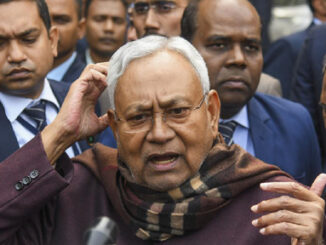
“Ultimately, America’s intervention reflected a pragmatic blend of nuclear risk management, geopolitical rivalry with China, and economic foresight. By acting decisively, the U.S. not only helped stabilize a volatile region but also reinforced its soft power, blocked adversarial diplomatic moves by Beijing or Moscow, and upheld the credibility of its global defense alliances.”

The Trump administration’s urgency in brokering a ceasefire between India and Pakistan in May 2025 was primarily driven by the imminent threat of nuclear escalation following a major terrorist attack in Indian-administered Kashmir. However, the unexpected performance of Chinese-made J-10C jets against India’s French-made Rafale fighters during the conflict also carried serious strategic implications—particularly for U.S. interests in the Indo-Pacific region.
Primary Reasons for U.S. Urgency in Securing the Ceasefire
- Nuclear Flashpoint: Risk of Escalation
India and Pakistan are long-standing nuclear-armed rivals. Any military confrontation—such as the 2019 Balakot airstrike and subsequent aerial skirmishes—raises the specter of nuclear war. In April 2025, after a terrorist attack in Kashmir killed 26 civilians, India launched retaliatory airstrikes. Pakistan responded by downing Indian aircraft and conducting its own strikes. Tensions peaked when India targeted Pakistan’s Nur Khan Air Base, located near its nuclear command center—triggering fears of a nuclear exchange. The Trump administration, led by Secretary of State Marco Rubio and Vice President JD Vance, acted swiftly to de-escalate the crisis, leading to a ceasefire announcement on May 10.
- Intelligence Warnings of Imminent Crisis
U.S. intelligence may have detected signs of imminent military escalation—such as troop movements or intelligence chatter about further terrorist plots—necessitating urgent diplomatic intervention to avert full-scale war.
- Global Stability and Strategic Interests
A prolonged conflict between two nuclear powers risked destabilizing the broader South Asian region. Spillover effects could impact Afghanistan, Iran, and even areas within China’s strategic orbit. For the U.S., preventing further destabilization was vital to maintaining global order and protecting its broader security agenda.
- Protecting Strategic Partnerships
- India as a Counterbalance to China: India plays a central role in America’s Indo-Pacific strategy. A protracted war would divert India’s resources away from countering China and could weaken U.S.-India defense and economic cooperation.
- Pakistan’s Influence in Afghanistan: Despite rocky relations, Pakistan remains influential in regional counterterrorism efforts and Afghanistan’s stability. U.S. diplomacy aimed to preserve leverage with both nations.
- Mitigating Global Economic Fallout
- Energy and Trade Routes: South Asia’s proximity to vital maritime lanes—including the Strait of Hormuz—means regional conflict could disrupt oil supplies, spike prices, and hamper global trade.
- Economic Interests in India: With significant American investments in India’s tech, defense, and manufacturing sectors (e.g., semiconductors), the U.S. had strong economic incentives to maintain regional stability.
- Counterterrorism Concerns
- Militant Networks in Pakistan: The U.S. has consistently pressured Pakistan to crack down on groups like Lashkar-e-Taiba and Jaish-e-Mohammed. A ceasefire could allow Islamabad to refocus on dismantling these threats.
- Preventing Radicalization: Escalation could fuel extremism, creating operational spaces for groups like ISIS-K and al-Qaeda.
- Countering China’s Expanding Influence
- Belt and Road Watchdog: China has heavily invested in Pakistan through the China-Pakistan Economic Corridor (CPEC) and is eager to play a larger diplomatic role in South Asia. U.S. mediation helped reassert American diplomatic leadership while countering China’s regional ambitions.
- Avoiding a China-Russia Mediation Bloc: Allowing China or Russia to step in as peace brokers would have diminished U.S. influence in the region and altered the diplomatic balance.
- Broader Geopolitical Priorities
- Focus on Ukraine and Taiwan: With the U.S. already stretched thin managing tensions in Eastern Europe and East Asia, resolving the South Asian crisis quickly helped avoid a third major theater of conflict.
- Quad Alliance Stability: A stable India is critical for the continued coherence of the Quad (U.S., India, Japan, Australia), which serves as a counterweight to China in the Indo-Pacific.
- Strategic Implications of J-10C Performance
During the aerial engagements, Pakistan reportedly used Chinese-made J-10C jets equipped with PL-15 long-range air-to-air missiles to down Indian Rafale jets. This marked the first real-world combat use of the J-10C, giving China valuable battlefield data on its weapons platforms.
- Broader Military and Technological Implications
- Perception of Chinese Military Technology: The success of the J-10C against Western aircraft could reshape global perceptions of Chinese military capabilities, particularly in air power.
- Impact on Taiwan and Regional Security: Taiwan’s military planners are likely to take note of these developments, especially as China aims to be ready for a possible invasion of Taiwan by 2027.
- Arms Market Dynamics: The J-10C’s performance could boost Chinese military exports, challenging U.S. dominance in the arms market and raising concerns for U.S. allies who rely on aircraft like the F-16, F/A-18, or F-35.
- Preserving U.S. Arms Market Leadership
The U.S. has vested interests in maintaining the global credibility of its defense technology. The perceived success of the J-10C—and the involvement of Pakistani F-16s (ironically U.S.-supplied)—could influence future arms procurement decisions in countries like Taiwan, Indonesia, and the UAE. A shift toward Chinese systems would weaken U.S. defense partnerships and economic leverage.
While the immediate trigger for the U.S.-brokered ceasefire was the urgent need to prevent nuclear escalation between India and Pakistan, deeper geopolitical and strategic considerations were at play. The strong battlefield showing of Chinese J-10C fighters added urgency and complexity to Washington’s calculus, as it signaled a possible shift in global military balance and regional security dynamics—especially for Taiwan and U.S. allies in Asia.
Ultimately, America’s intervention reflected a pragmatic blend of nuclear risk management, geopolitical rivalry with China, and economic foresight. By acting decisively, the U.S. not only helped stabilize a volatile region but also reinforced its soft power, blocked adversarial diplomatic moves by Beijing or Moscow, and upheld the credibility of its global defense alliances.
(Compiled by Dave Makkar from various sources across the internet)





Be the first to comment